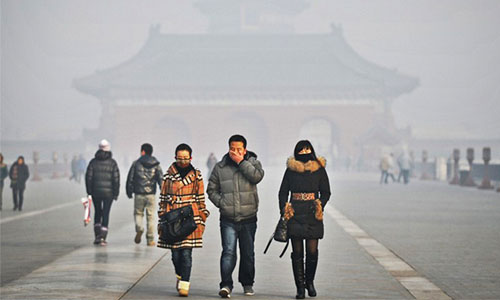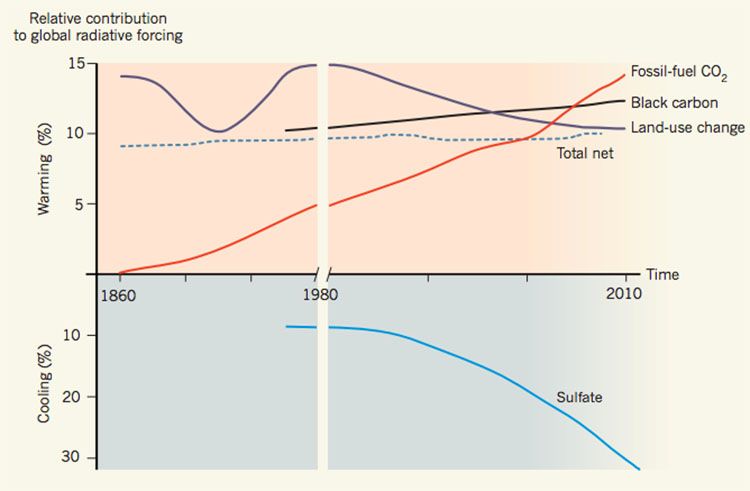

Relative Contribution
To put the changes within China into a global context, the inset graph in the figure above shows the warming effect of Chinese greenhouse gases as a percentage of the global total.
Again, the impact of China’s recent fossil fuel expansion is clear, with the country’s contribution to total global fossil fuel CO2 almost tripling in the 30-year period between 1980-2010.
China currently accounts for 12 percent of the total greenhouse gases in the atmosphere—a figure that has remained fairly steady over the industrial period, at around 8-12 percent (blue line). This is effectively the balance of impacts from all China’s greenhouse gas emissions over time—i.e. carbon dioxide, methane, nitrous oxide and halogen compounds—and from all anthropogenic sources.
The 10 percent figure is lower than might be expected for the country topping of the list of the biggest emitters. But it reflects the fact that others, such as the U.S. and the EU, have been emitting far longer, the paper notes. The paper does not calculate the contributions from these other entities, so a direct comparison is not possible.
Relative to the rest of the world, China’s share of greenhouse gas warming fell slightly in the 1960s, 70s and 80s before starting to climb again as economic growth and fossil fuel burning accelerated.
But there’s something else going on, too. China is responsible for a disproportionate amount of the aerosols emitted around the world, some of which have a strong cooling effect.
Cooling Effect
According to the new study’s results, China is responsible for 28 percent of the sulphate aerosols currently in the atmosphere (light blue bar in the graph below), 24 percent of nitrate aerosols (dark blue) and 14 percent of black carbon (pink).
Importantly, while the U.S. and Europe have been slashing sulphates in an effort to improve air quality, China’s aerosol emissions have been on the rise. Spracklen said:
“Air pollution is a serious environmental issue in China, where 1.3m people die each year because of exposure to poor-quality air outdoors.”
As well as posing a growing public health crisis, sulphate aerosols have a strong cooling effect. Over the past few decades, this has been pulling in the opposite direction to rising CO2, methane and black carbon emissions, effectively muting China’s relative impact on global temperature.
As the graph below from Spracklen’s News and Views article shows, the balance between warming (red shading) and cooling (blue shading) have kept the country’s contribution to human-caused climate change pegged at about 10 percent in recent decades, despite soaring fossil fuel emissions.
The implication is that if China follows the rest of the world in cutting sulphate aerosols in a bid to reduce air pollution, global temperatures could rise even faster in the coming decades since there would be less of a cooling effect to offset the warming. But this is no reason to avoid doing it, said Spracklen:
“This means that it will be difficult to achieve rapid reductions in near-term global warming through the control of Chinese air pollutants overall—a focus on greenhouse-gas emissions, in particular, will be required.”
But given the upwards trend in fossil fuel CO2 emissions, the long lifetimes of existing infrastructure and the social and political systems in place, it is “unlikely” that China’s relative contribution to global greenhouse gas warming will come down any time soon, say the authors in the paper.
While the study goes further than previous ones in terms of pinning down China’s total contribution to climate change, the authors acknowledge a lot of remaining uncertainty, particularly about China’s methane and sulphur dioxide emissions.
There is also work to be done in completing the complex picture of influencing factors. For example, the authors acknowledge the role of aerosols in stimulating clouds to form and the darkening of snow and ice by black carbon, adding that there is still too much uncertainty to include fully in their calculations.
YOU MIGHT ALSO LIKE
Worldwide Shift to Renewable Energy Played ‘Critical Role’ in Stalling Carbon Emissions
What Garland’s Supreme Court Nomination Could Mean for the Climate
Ice Shelf Twice the Size of Manhattan Is About to Break Off From Antarctica
1 in 4 Deaths Worldwide Caused by Preventable Environmental Factors

 233k
233k  41k
41k  Subscribe
Subscribe 

